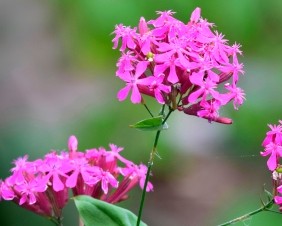Sweet William catchfly
(Atocion armeria)

Description
Silene armeria, commonly known as the Sweet William catchfly, is a species of plant in the family Caryophyllaceae. Originally a native of Europe, it has become widespread in the United States. Perennial in USDA plant hardiness zones 5 to 8. A small-growing form is known as dwarf catchfly. The name comes from the way in which small insects are trapped by the sticky sap exuded onto the stem. However it is not currently regarded as a carnivorous plant, though it has been identified as a carnivorous plant in the past. The plant between 20 and 70 cm in height. Leaves numerous 2.5–5 cm long, elliptic, oval, or narrowly oval, smooth. Blooming period in British Isles - Jun-Oct. Clusters of pink or lavender flowers arranged somewhat openly or compactly at end of stems. Stem hairless (glabrous) or slightly hairy with sticky areas, especially just below the cluster. A plant native of Europe in roadsides, weedy places. Has been introduced to North America and later escaped cultivation to become an invasive species. Silene is a genus of flowering plants in the family Caryophyllaceae. Containing nearly 900 species, it is the largest genus in the family. Common names include campion and catchfly. Many Silene species are widely distributed, particularly in the northern hemisphere. Members of this genus have been the subject of research by preeminent plant ecologists, evolutionary biologists, and geneticists, including Charles Darwin, Gregor Mendel, Carl Correns, Herbert G. Baker, and Janis Antonovics. Many Silene species continue to be widely used to study systems, particularly in the fields of ecology and evolutionary biology. The genus has been used as a model for understanding the genetics of sex determination for over a century. Silene species commonly contain a mixture of hermaphroditic and female (or male-sterile) individuals (gynodioecy), and early studies by Correns showed that male sterility could be maternally inherited, an example of what is now known as cytoplasmic male sterility. Two independent groups of species in Silene have evolved separate male and female sexes (dioecy) with chromosomal sex determination that is analogous to the system found in humans and other mammals. Silene flowers are frequently visited by flies, such as Rhingia campestris.
Taxonomic tree:







